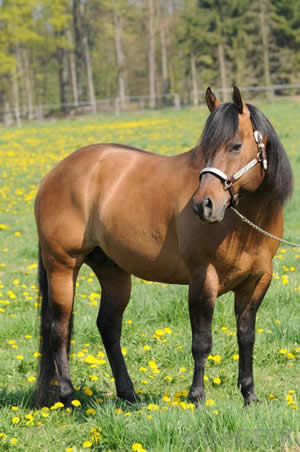General Description
The Quarter Pony is a small scale replica of a Quarter Horse. Unlike the Quarter Horse, it may come in any color, or combination of colors. The Quarter pony has been around for many years, deriving from Quarter Horses not reaching the AQHA's minimum (14.2h) height requirement of the early years. Even though the AQHA's height requirement was later phased out, the quarter pony continued.
The most recent evolution in the quarter pony industry is the acceptance of various colors and color patterns, rather than sticking to the original standard of only accepting solid colored ponies for registration. Acceptance of colors is enabling breeders to breed those all so sought-after color patterns such as the tobiano and overo paint patterns as well as the blanketed appaloosa patterns onto to the quarter pony size and conformation. Known quarter horse bloodlines are encouraged but not required.
The Quarter Pony is perfectly suited for riders who are too small to handle, or simply don't wish to handle a big 15 or 16 hand horse. Most quarter ponies average approximately 13.2h and weigh 800-900lbs. However, many breeders are beginning to raise quarter ponies weighing in excess of 1100lbs. at 13.2h-14h tall. These heavily muscled quarter ponies are quite suitable for larger riders and are often being used to compete in such (mostly adult) events as Bull Dogging(Steer Wrestling). The Quarter Pony is a conformation and height breed, which must display quarter type characteristics and measure between 11.2h(46") and 14.2h (58") at the withers at maturity.
Head: The head of the quarter pony reflects alert intelligence. This is due to his short, broad head, topped by small ears, and by his wide set, kind eyes and large, sensative nostrils over a firm mouth. Well developed jaws give the impression of great strength.
Neck: The head of the quarter pony joins the neck at a near forty-five degree angle, with a distance between jaw-bone and neck muscle. The medium length, slightly arched neck blends into sloping shoulders.
Shoulders: The quarter pony's unusually good saddle back is created by his medium-high but sharp wither extending well back and combining with his deep sloping shoulders so that the saddle is held in proper position for balanced action.
Chest And Forelegs: The quarter pony is deep and broad chested, as indicated by his great heart girth and his wide set, heavy forelegs which blend into his shoulders. The smooth joints and very short cannons are set on clean fetlocks and the medium length pasterns are supported by sound feet. The powerfully muscled forearm tapers to the knee whether viewed from the front or the side.
Back: The short saddle back of the quarter pony is characterized by being close coupled and especially full and powerful across the kidney. The barrel is formed by deep, well sprung ribs back to the hip joints, and the underline comes back straight to the flank.
Rear Quarters: The rear quarters are broad, deep and heavy, viewed from either side or rear, and are muscled so they are full through the thigh, stifle, gaskin, and down to the hock. The hind leg is muscled inside and out, the whole indicating the great driving power the quarter pony possesses. When viewed from the rear, there is great width extending evenly from top of thigh to bottom of the stifle and gaskin. The hocks are wide, deep, straight, and clean.
Bone, Legs, & Feet: The flat, clean bones are free from fleshiness and puffs that still show great substance. The foot is well rounded and roomy, with an especially deep, open heel.
Stance: The quarter pony normally stands perfectly at ease with his legs well under him, this explains his ability to move quickly in any direction.
Action: The quarter pony is very collected in his action and turns or stops with noticeable ease and balance, with his hocks always well under him.






